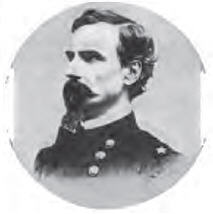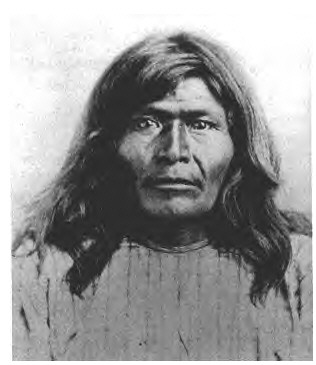
Cochise was the Mexican leader of the Chiricahui local group of the Chokonen and principal nantan of the Chokonen band of a Chiricahua Apache. A key war leader during the Apache Wars, he led an uprising that began in 1861 and persisted until a peace treaty was negotiated in 1872. Cochise County is named after him.

Jicarilla Apache, one of several loosely organized autonomous bands of the Eastern Apache, refers to the members of the Jicarilla Apache Nation currently living in New Mexico and speaking a Southern Athabaskan language. The term jicarilla comes from Mexican Spanish meaning "little basket", referring to the small sealed baskets they used as drinking vessels. To neighboring Apache bands, such as the Mescalero and Lipan, they were known as Kinya-Inde.

The Comanche Wars were a series of armed conflicts fought between Comanche peoples and Spanish, Mexican, and American militaries and civilians in the United States and Mexico from as early as 1706 until at least the mid-1870s. The Comanche were the Native American inhabitants of a large area known as Comancheria, which stretched across much of the southern Great Plains from Colorado and Kansas in the north through Oklahoma, Texas, and eastern New Mexico and into the Mexican state of Chihuahua in the south. For more than 150 years, the Comanche were the dominant native tribe in the region, known as “the Lords of the Southern Plains”, though they also shared parts of Comancheria with the Wichita, Kiowa, and Kiowa Apache and, after 1840, the southern Cheyenne and Arapaho.

The Apache Wars were a series of armed conflicts between the United States Army and various Apache tribal confederations fought in the southwest between 1849 and 1886, though minor hostilities continued until as late as 1924. After the Mexican–American War in 1846, the United States annexed conflicted territory from Mexico which was the home of both settlers and Apache tribes. Conflicts continued as American settlers came into traditional Apache lands to raise livestock and crops and to mine minerals.

The First Battle of Adobe Walls took place between the United States Army and Native Americans. The Kiowa, Comanche and Plains Apache tribes drove from the battlefield a United States column that was responding to attacks on white settlers moving into the Southwest. The battle on November 25, 1864, resulted in light casualties on both sides.

Philip St. George Cooke was a career United States Army cavalry officer who served as a Union General in the American Civil War. He is noted for his authorship of an Army cavalry manual, and is sometimes called the "Father of the U.S. Cavalry."

The Ute Wars were a series of conflicts between the Ute people and the United States which began in 1849 and ended in 1923.

The Apache Scouts were part of the United States Army Indian Scouts. Most of their service was during the Apache Wars, between 1849 and 1886, though the last scout retired in 1947. The Apache scouts were the eyes and ears of the United States military and sometimes the cultural translators for the various Apache bands and the Americans. Apache scouts also served in the Navajo War, the Yavapai War, the Mexican Border War and they saw stateside duty during World War II. There has been a great deal written about Apache scouts, both as part of United States Army reports from the field and more colorful accounts written after the events by non-Apaches in newspapers and books. Men such as Al Sieber and Tom Horn were sometimes the commanding officers of small groups of Apache Scouts. As was the custom in the United States military, scouts were generally enlisted with Anglo nicknames or single names. Many Apache Scouts received citations for bravery.

The Battle of Cieneguilla was an engagement of the Jicarilla War involving a group of Jicarilla Apaches, possibly their Ute allies, and the American 1st Cavalry Regiment on March 30, 1854 near what is now Pilar, New Mexico. The Santa Fe Weekly Gazette reported that the action "was one of the severest battles that ever took place between American troops and Red Indians." It was one of the first significant battles between American and Apache forces and was also part of the Ute Wars, in which Ute warriors attempted to resist Westward expansion in the Four Corners region.
Cantonment Burgwin was a U.S. Army fort in the southwestern United States, located ten miles (16 km) south of Taos, New Mexico, southeast of Ranchos de Taos.

John Wynn Davidson was a brigadier general in the United States Army during the American Civil War and an American Indian fighter. In 1850, he co-led the Bloody Island massacre of 60-200 Pomo old men, women, and children as part of the wider California genocide.
The Battle of Ojo Caliente Canyon, or simply the Battle of Ojo Caliente was an engagement of the Jicarilla War on April 8, 1854. Combatants were Jicarilla Apache warriors, and their Ute allies, against the United States Army. The skirmish was fought as result of the pursuit of the Jicarilla after the Battle of Cieneguilla just over a week earlier.

Victorio's War, or the Victorio Campaign, was an armed conflict between the Apache followers of Chief Victorio, the United States, and Mexico beginning in September 1879. Faced with arrest and forcible relocation from his homeland in New Mexico to San Carlos Indian Reservation in southeastern Arizona, Victorio led a guerrilla war across southern New Mexico, west Texas and northern Mexico. Victorio fought many battles and skirmishes with the United States Army and raided several settlements until the Mexican Army killed him and most of his warriors in October 1880 in the Battle of Tres Castillos. After Victorio's death, his lieutenant Nana led a raid in 1881.

The White massacre was an engagement between American settlers and a band of Utes and Jicarilla Apaches that occurred in northeastern New Mexico on October 28, 1849. It became notable for the Indians' kidnapping of Mrs. Ann White, who was subsequently killed during an Army rescue attempt a few weeks later.
The Fort Pueblo massacre was an attack that occurred on December 25, 1854, against Fort Pueblo, Colorado, also known as El Pueblo, a settlement on the north side of the Arkansas River, 1⁄2 mile west of the mouth of Fountain Creek, above the mouth of the Huerfano. The attack followed the deaths of Chief Chico Velasquez and others who died of smallpox after having been given blanket coats which the Muache believed had been deliberately contaminated. Coalition forces of over 100 Muache Utes and Jicarilla Dindes under the leadership of Chief Tierra Blanco led the attack against Fort Pueblo, killing 15 men, and capturing one woman, and two boys. Later on, the Muache killed the woman south of Pueblo along Salt Creek. Two women and one man survived the joint military operation, and the two boys who were captured eventually returned.
Flechas Rayadas or Striped Arrows was a Jicarilla Apache chief of the band that, together with Francisco Chacon's warriors, defeated Lieutenant Davidson's detachment of 60 men from the First Regiment of Dragoons in the Battle of Cieneguilla, in the Embudo Mountains, on April 4, 1854, killing 22 and wounding 36. On April 7, as Lieutenant Colonel Cooke was pursuing the Jicarillas, General Garland sent word to Cooke that Flechas Rayadas had offered to return all the horses and arms captured in that fight if peace could be made; the chief's proposal was rejected.
Francisco Chacon was a Jicarilla Apache chief, leader in the Jicarilla uprising of 1854. He led the band that defeated the Davidson detachment of the First Regiment of Dragoons in the Battle of Cieneguilla: the Jicarilla, led by Francisco Chacon, their principal chief, and Flechas Rayadas, fought with flintlock rifles and arrows, killing 22 and a wounding another 36 of 60 dragoon soldiers, who then retreated to Ranchos de Taos lighter by 22 horses and most of the troops' supplies.
Lobo Blanco or White Wolf was a Jicarilla Apache chief of the band that, with 30 warriors, raided the horse herd of the Second Regiment of Dragoons at Fort Union, and, reached up near the Canadian River, was defeated by Lieutenant Bell's Dragoon detachment in the Battle of Canadian River on April 4, 1854, before the Battle of Cieneguilla; repeatedly wounded, the chief was finally killed crushing him under a boulder.
Chico Velasquez was a leader of the Jicarilla Apache and Ute people. He was originally closely associated with the Jicarilla and was blamed for attacks on Americans in the early part of the Jicarilla War. Velasquez met with American leaders in 1850 and promised not to take up arms against Americans and Mexicans. By 1854 he was working with the American governor of New Mexico David Meriwether to recover stolen American livestock. As reward for searching for a fugitive murderer, Velasquez was given an embroidered gray coat, but that coat and blankets given to the Ute at the same time were infected with smallpox. The disease killed Velasquez and many other Ute and was one of the causes of the Fort Pueblo Massacre.
Pionsenay was a Chiricahua Apache war chief from Arizona. He was a fierce raider who advocated for war against the Americans, in opposition to the sons of Cochise who advocated for peace. Pionsenay killed several white men including U.S. Army Sergeant Orizoba Spence. His actions sparked the Americans' forced relocation of the Chiricahua to the San Carlos Apache Indian Reservation.













